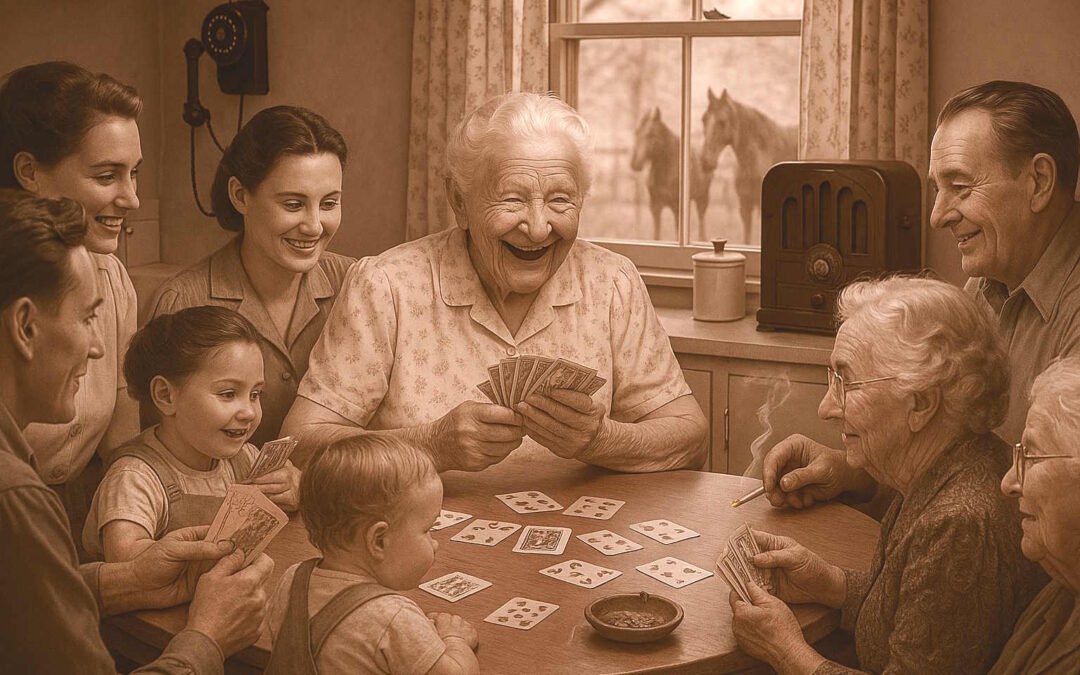A Legacy from the Horse and Buggy Days
My cousin Vicki once said something that captured the awe we all feel when we talk about our family’s history:
“Granny Eva was alive when horses were still on the street.”
She said it almost in disbelief—as if the world that Granny lived in was too far gone to be real. And in many ways, it was. In the late 1800s, the rolling hills of Floyd County, Indiana, were crisscrossed by dusty roads where horses pulled carts, carriages, and farm wagons. Some folks simply rode bareback. The pace of life was slower, marked by the rhythms of the seasons and the tolling bells of churches like St. Mary of the Knobs. It was into this world that our family matriarch, Granny Eva, was born in 1885.
She married just past the turn of the century at the age of 18, raised ten children, and lived an astonishing 106 years. Her children spanned such a broad stretch of time that my father’s first cousin was only a few years older than I was. That’s how wide her reach was—and still is.
Gentle and Cheerful
Granny Eva was a gentle and cheerful soul. She was known for her card-playing love, and even at family gatherings that stretched into the night, after midnight, she’d still ask, “Well, who’s up for a game of euchre?” The kitchen table would fill again, the whiskey might be passed around, and the laughter would pick up once more. She was always there—a constant, steady presence at the center of things.
Sundays were sacred for the family, not just for church, but for going “back home.” That phrase meant piling into cars, showing up unannounced at the old homeplace, and spending the afternoon together. We grandkids would run off into the hills, swing on vines, clamber around the hay bales in the barn, or skip stones down by the creek. It was a kind of quiet joy we didn’t realize was special until much later.
Witness to a Century of Change
Granny lived through a staggering amount of history—two world wars, the Great Depression, man landing on the moon, the jet age, and the chaos and change of the 1960s. When she passed away in the early 1990s, she was surrounded by her children, praying the rosary at her bedside. That image alone tells you everything about the kind of family she helped form—rooted in faith, togetherness, and endurance.
At age 100, she threw a family reunion that filled the parish hall. We hardly recognized half the people there. My cousin Vicki made a massive poster chronicling all of Granny’s children and descendants—there were nearly three hundred grandchildren and great-grandchildren. Somewhere there’s a black-and-white photo of Granny signing her name to that family tree. She’s looking into the camera with a tired but deeply contented face.
Half the County
I remember one reunion in particular when my father and I stopped in a barbershop in town on our way to the old homestead. We struck up a conversation with a local man and mentioned our last name. He paused and said, “If all the Banets got up and left this county, there’d only be half the people left.” We laughed, but there was a truth in it. One family really can shape a place.
My father was the keeper of much of our family’s story. He traced our roots to Étienne Banet, the first of our line to arrive from France in 1836. Étienne came through New Orleans and made his way north, buying 640 acres of land and setting up the first sawmill in Floyd County. He brought with him a grandfather clock decorated with Napoleonic symbols and named his daughter Josephine—perhaps in honor of the Empress. These were small but powerful echoes of the old world.
Sawmill and Strong Roots
Étienne and his wife Françoise had 12 children. Their daughter was the first child to be baptized in the county. I imagine that their names now rest in stone in the cemetery in front of St. Mary of the Knobs. There’s a photo of me from the 1970s, squatting beside Étienne’s tombstone with my long hair and a big smile. That photo means more to me now than it ever did then.
Now, my college-aged son is talking about making a trip back to Floyd County with his cousin. He wants to see those hills, those barns, those churches—and he wants to know where it all began. He’s curious about the old grandfather clock that Étienne brought with him. We have a faded photo of it somewhere, beat-up and beautiful. We don’t know where it is now, or if it still exists. But he wants to look. He wants to know.
New Steps to Explore the Past
Maybe we’ll go together, he and I with a few cousins. Maybe we’ll find the road that still bears our family name. Maybe we’ll walk through the cemetery and visit the church, feel the air, and meet cousins we’ve never met. Maybe, in doing that, we’ll pass on something essential.
Because family history matters. It’s the thread that ties us to each other. It reminds us that we are not isolated, but part of something bigger—generations long and wide, built on love and struggle. My father’s genealogy work focused mostly on the male side, but there’s a rich and untold story in the German names of our mother’s line—Zimmerman, Schmidt, Sermersheim—names rooted in the Ohio River Valley and steeped in immigrant grit and grace. Maybe someone else will unearth that treasured history.
When families move away for work or life, something always gets left behind. Family traditions can fray. But reunions, storytelling, and a search for heritage knits the threads back together. They strengthen marriages, preserve memories, and remind us that we belong to one another.
Someday, someone may look back at our generation and say, “Can you imagine it? Grandpa and Grandma lived before the internet, before AI, before smartphones.”
History isn’t just in books—it’s in barns, kitchens, and small-town barbershops where people still remember your name. When we share stories, we keep our ancestors alive—and pass on strength to the next generation.

